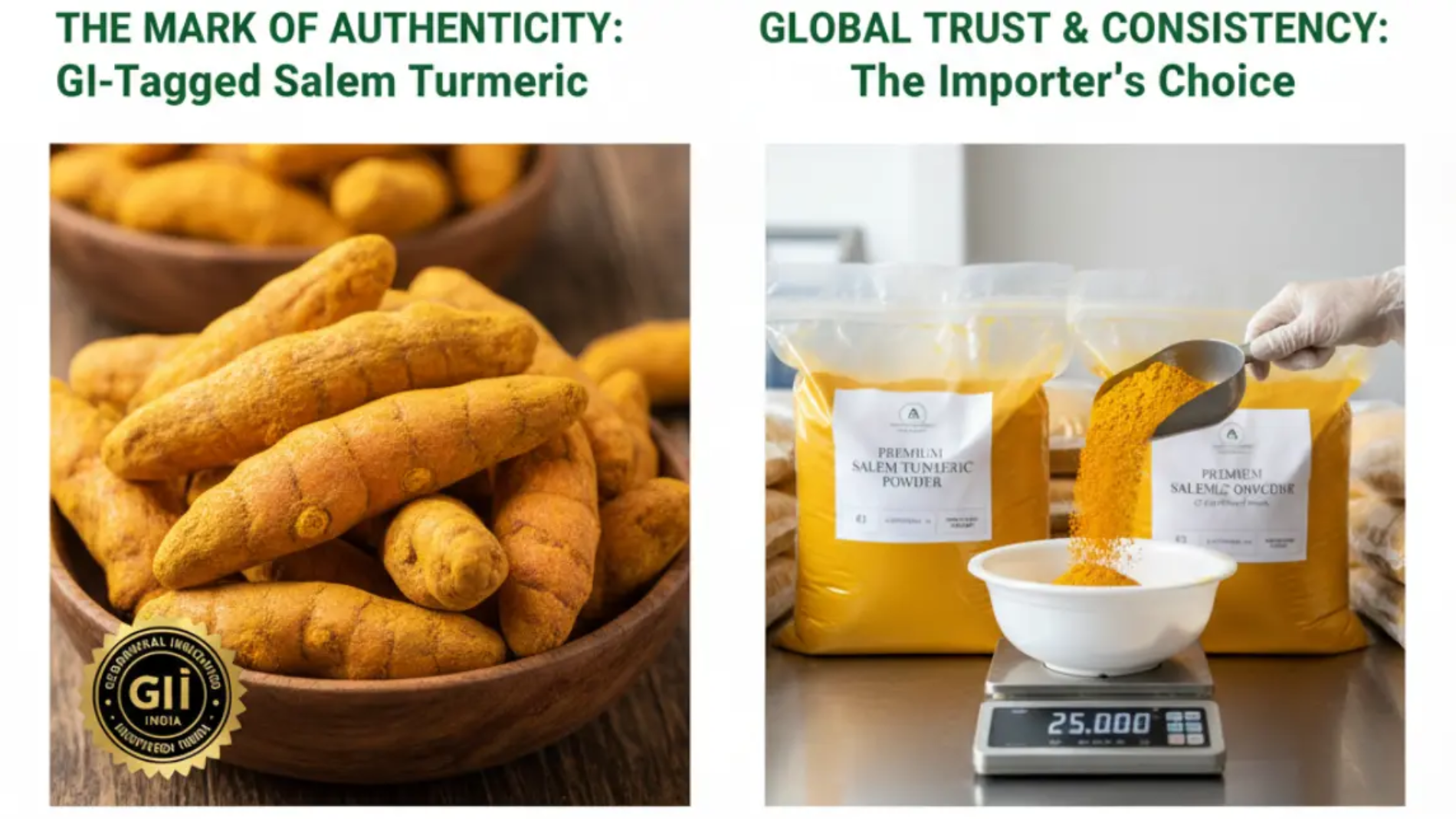In the dynamic landscape of the global spice trade, savvy spice importers are constantly seeking more than just commodities. They are looking for products that tell a story of quality, authenticity, and reliability. In the vast market of Indian turmeric, a distinct trend has emerged: a growing and significant international focus on sourcing one particular variety—GI-tagged Salem turmeric.
This is not a fleeting trend but a strategic shift. Businesses are recognizing that this specific variety offers a unique combination of verifiable quality and commercial advantages. As an experienced exporter based in Pune, we’ve witnessed this rise in demand firsthand. This article will explore the key reasons why importers worldwide are increasingly specifying Salem Turmeric export shipments, making it one of the most sought-after spices on the global stage.
1. The Ultimate Assurance: The Geographical Indication (GI) Tag
The single most powerful factor driving the demand for Salem turmeric is its Geographical Indication (GI) tag. Similar to protected origins like Champagne in France or Parmesan in Italy, this GI tag is a legal guarantee, recognized internationally, that the turmeric originates from the Salem region of Tamil Nadu and possesses the specific qualities attributed to that region.
For an importer, this is the ultimate assurance, providing:
Guaranteed Authenticity: It offers irrefutable proof of origin, eliminating the risk of sourcing turmeric from other regions being sold under a premium name.
Risk Mitigation: The GI system protects against adulteration and ensures that the product has met strict quality control standards.
A Powerful Marketing Tool: Importers and their retail clients can use the prestigious GI tag to market the product with a compelling story of verified quality and tradition.
2. A Consistent and Balanced Profile for Maximum Versatility
While some turmeric varieties are known for a single dominant trait (like extremely high curcumin or intense colour), Salem turmeric is prized for its perfect balance.
Its curcumin content is consistent and moderate, typically ranging from 3-5%. This “golden mean” makes it incredibly versatile for food manufacturers. It’s potent enough to provide significant health benefits and a vibrant colour, but not so overpowering that it disrupts the delicate flavour architecture of complex spice blends. Its classic warm, earthy flavour and deep yellow-orange hue are highly reliable, ensuring product consistency for brands.
Spice Up Your Business with Authentic Indian Flavors
Import and Export Excellence from India!

3. Superior Physical Characteristics of the "Finger"
Salem turmeric is famous for the quality of its whole, dried rhizome, known in the trade as the turmeric finger. The fingers from the Salem region are typically larger, plumper, and more robust than many other varieties.
This matters to importers for several practical reasons:
Less Breakage: The hardiness and size of the fingers mean less product loss from breakage during shipping and handling.
Visual Appeal: For the whole spice market, a large, uniform, and visually appealing finger is a strong indicator of high quality.
High Powder Yield: The substantial size means it yields a high quantity of powder when ground at its destination.
4. A Stable, Mature, and Scalable Supply Chain
Salem is one of India’s primary, long-established hubs for turmeric cultivation and trade. For an importer, this translates into a mature and highly reliable supply chain. This stability is a significant business advantage, providing:
Scalability: The ability to source large, consistent volumes to meet the demands of growing markets.
Experienced Partners: Access to a deep network of experienced farmers, processors, and a professional Indian turmeric supplier who understands the nuances of export quality and documentation.
Market Stability: A large, established market is generally less prone to the extreme price volatility that can affect smaller, more niche producing regions.
5. Meeting the Global Demand for Traceable Spices
The modern consumer wants to know where their food comes from. This demand for transparency and traceability has moved up the supply chain and is now a key consideration for importers and retailers. The GI tag is the perfect answer to this trend.
By focusing on a GI-tagged product like Salem Turmeric export shipments, importers are aligning their business with the future of the food industry. They can offer their clients a product with a built-in, verifiable story of origin, quality, and authenticity.
Spice Up Your Business with Authentic Indian Flavors
Import and Export Excellence from India!

In conclusion, the global focus on Salem turmeric is a calculated business decision. It represents a move towards products that offer verifiable quality, a compelling marketing story, and a reliable supply chain. For importers looking to build a reputation based on trust and premium quality, sourcing spices from India, and specifically GI-tagged Salem turmeric, is a powerful strategy for success.
Frequently Asked Questions (FAQs)
1. How does the Salem turmeric GI tag differ from the one for Erode turmeric?
Both are GI-tagged varieties from Tamil Nadu. Salem is often prized for its larger finger size and balanced profile, making it a versatile export favourite. Erode, from “Turmeric City,” is also an excellent all-rounder with a strong market presence. The choice often comes down to specific buyer preferences for size and flavour nuances.
2. What is the best way to market a GI-tagged product to my customers?
Highlight the GI tag on your packaging and marketing materials. Use phrases like “Authentic Salem Turmeric,” “Guaranteed Origin,” and “GI Protected.” Tell the story of its origin in Tamil Nadu to build a connection with consumers who value authenticity.
3. Is Salem turmeric primarily exported as fingers or powder?
It is heavily traded in both forms. The whole turmeric finger is popular for its visual appeal in the whole spice market, while the powder is used for its convenience in manufacturing and retail.
4. What documents are needed to verify the GI tag?
A reputable supplier should be a GI Authorized User and be able to provide their authorization certificate. The product packaging for export will also often carry the official GI logo.
5. What is the typical curcumin content of Salem turmeric?
Salem turmeric generally has a consistent curcumin content ranging from 3% to 5%, making it a potent and reliable choice for most food applications.
6. Is Salem turmeric suitable for the nutraceutical industry?
While varieties like Alleppey are often sought for their exceptionally high curcumin (5%+), the verified purity and consistent potency of GI-tagged Salem turmeric make it a trusted and reliable ingredient for many nutraceutical applications as well.
7. When is the harvest season for Salem turmeric?
The main harvest season for turmeric in the Salem region is typically from January to March each year.
8. How can I ensure I’m partnering with a legitimate Indian turmeric supplier?
Look for a supplier who is a registered exporter with the Spices Board of India, has experience with GI-tagged products, and can readily provide a comprehensive Certificate of Analysis (COA), along with their quality and food safety certifications (like ISO, HACCP).
About us
We bridge the gap between local producers and global markets, ensuring seamless trade facilitation with exceptional quality and reliability. We provide quick delivery services with customized packaging with all approval of International Certificates (Spices board India, MSME, IEC, fssai, FIEO, APEDA, EU certification, FDA and Many More)
Contact us
Shop No. 3, Ganesh Prestige Sr. No. 2/15, Near Laxmi Jewellers, Dhanakawadi, Pune – 411043, Maharashtra INDIA.
Call On
+91 9545205050
+91 9822422584



Leave A Comment